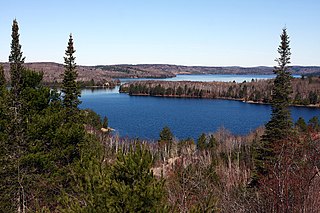
Elliot Lake is a city in Algoma District, Ontario, Canada. It is north of Lake Huron, midway between the cities of Sudbury and Sault Ste. Marie in the Northern Ontario region. Once dubbed the "uranium capital of the world," Elliot Lake has since diversified to a hub for forest harvesting, mine reclamation expertise, and advanced manufacturing. Elliot Lake is now known as a place for affordable retirement living, waterfront cottage lots and as a four-season destination.

Elie Walter Martel is a former politician in Ontario, Canada. He served in the Legislative Assembly of Ontario from 1967 to 1987, as a member of the New Democratic Party (NDP).
James Milton Ham, was a Canadian engineer, university administrator and President of the University of Toronto.
The National Day of Mourning, or Workers' Mourning Day is observed in Canada on 28 April. It commemorates workers who have been killed, injured or suffered illness due to workplace related hazards and occupational exposures.

Denison Mines Corp. is a Canadian uranium exploration, development, and production company. Founded by Stephen B. Roman, and best known for its uranium mining in Blind River and Elliot Lake, it later diversified into coal, potash, and other projects.
Rio Algom was a mining corporation that was purchased by Billiton in 2000 and is now part of BHP.

Madawaska Mine (previously known as Faraday Mine) is a decommissioned underground uranium mine in Faraday, near the town of Bancroft, Ontario, which produced 9 million pounds (4,082 tonnes) of U3O8 concentrate, at an average ore grade of 0.1074%, during its two periods of production.
The Spanish American Mine is a historical uranium mine located approximately 11 km (7 mi) northeast of Elliot Lake, Ontario, owned and operated by Rio Algom Ltd. The site is 2.3 km (1 mi) southeast of the Denison Mine.
The Stanrock Mine is an historical uranium mine located approximately 11.5 km northeast of Elliot Lake, Ontario, owned by Denison Mines. The site has been decommissioned and rehabilitated with ongoing monitoring by Denison Environmental Services.
The Pronto Mine is an historical uranium mine located approximately 20 km south of Elliot Lake, Ontario near Spragge. The site is owned and operated by Rio Algom Ltd, has been rehabilitated and is currently undergoing environmental monitoring.

The Buckles Mine is an historical uranium mine located approximately 4.5 km southeast of Elliot Lake, Ontario, owned and operated by Rio Algom Ltd. The site has been rehabilitated. Environmental monitoring is ongoing as part of the monitoring for the nearby Nordic Mine.
The Can-Met Mine is an abandoned uranium mine located approximately 12.5 km northeast of Elliot Lake, Ontario, owned by Denison Mines Ltd. The site has been rehabilitated and its tailings facility is currently undergoing environmental monitoring by Denison Environmental Services.
The Lacnor Mine, is an abandoned uranium mine in the Elliot Lake area of Ontario, owned by Rio Algom Ltd. The site has been rehabilitated and its tailings facility is currently undergoing environmental monitoring by Denison Environmental Services.
Consolidated Denison Mine, or the Denison Mine is an abandoned uranium mine located approximately 12.5 km north of Elliot Lake, Ontario. The site is bordered north by Pronto Mine, Quirke Mine and Nordic Mine; on the east by Panel Mine and Can-Met Mine; and south by Spanish American Mine and Stanrock Mine.

Canada is the world's second largest producer of uranium, behind Kazakhstan. In 2009, 20% of the world's primary uranium production came from mines in Canada. 14.5% of the world production came from one mine, McArthur River. Currently the only producing area in Canada is northern Saskatchewan, although other areas have had active mines in the past.

Ontario Mine Rescue is the program that creates, oversees and evaluates mine rescue training and standards in the province of Ontario. The Ontario Mine Rescue program is administered by Workplace Safety North, part of the prevention arm of the Ontario Ministry of Labour.

Mines in Bancroft produced uranium from 1956–1964 and again from 1975–1982. During those times, Bancroft was one of two major uranium-producing areas in Ontario, and one of seven in Canada, all located along the edge of the Canadian Shield. In the context of mining, the "Bancroft area" includes Haliburton, Hastings, and Renfrew counties, and all areas between Minden and Lake Clear. Activity in the mid-1950s was described by engineer A. S. Bayne in a 1977 report as the "greatest uranium prospecting rush in the world". Mining activities were conducted during two periods, 1956–1964 and 1975–1982, when uranium prices made underground hard-rock mining of the ores economically viable.
The Royal Commission on the Health and Safety of Workers in Mines, informally known as the Ham Commission, was a 1974 Canadian royal commission founded to investigate and report on the safety of underground mines.

Uranium mining in the Elliot Lake area represents one of two major uranium-producing areas in Ontario, and one of seven in Canada.

Quirke Lake is body of water located in Ontario, Canada. It is located in the Quirke Lake basin, a geological basin the northern part of the Huronian Supergroup. The lake is proximate to five decommissioned uranium mines.








